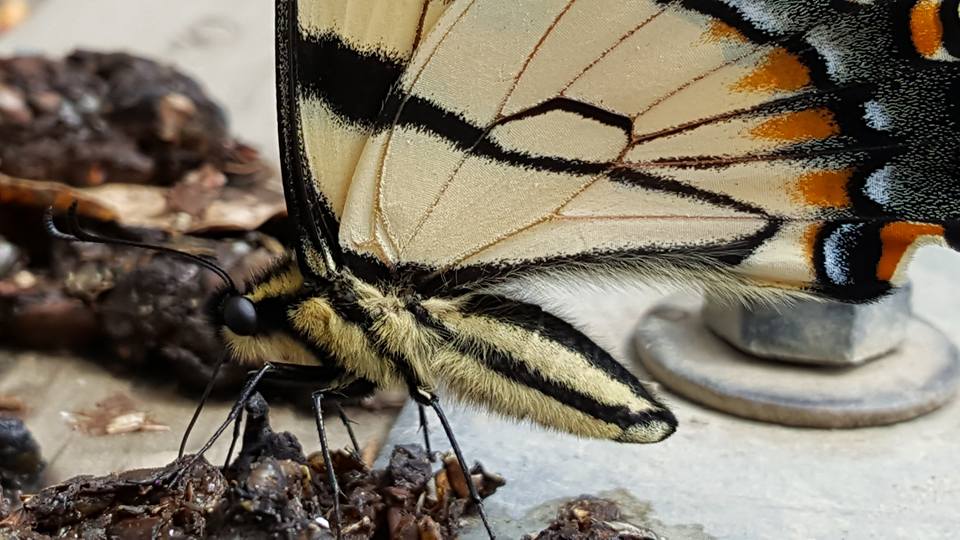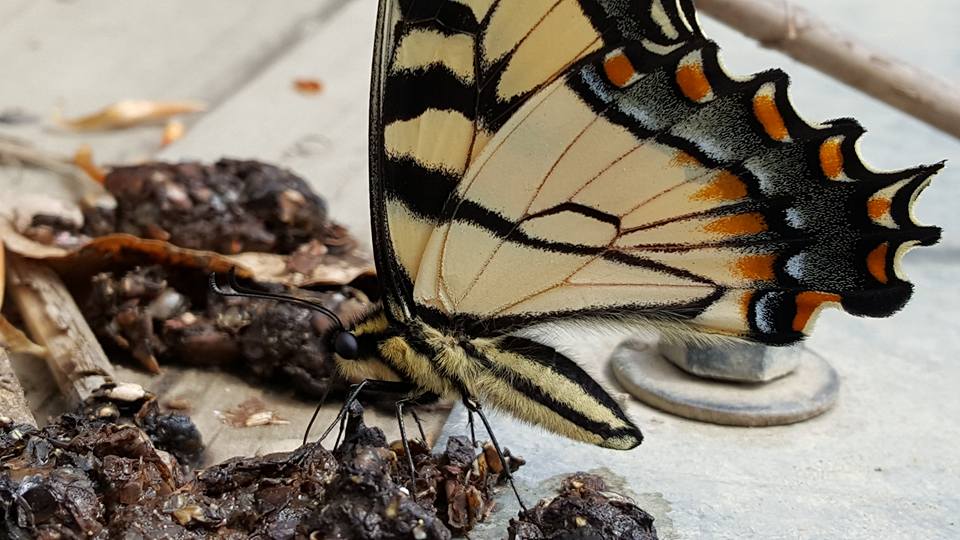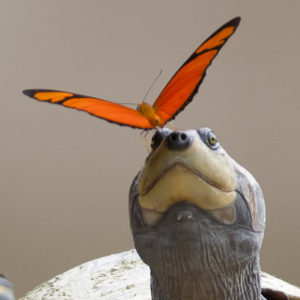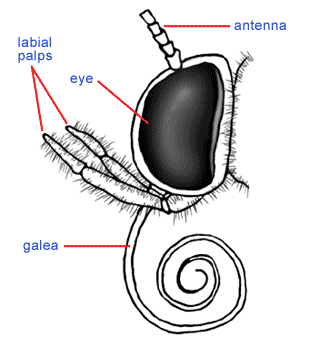Introducing the Butterfly Proboscis (Snoot, Sippy Straw & Sponge)

How Butterflies Get Their Fluids
I think I have a form of nature attention deficit disorder because I get so easily distracted by anything in the natural world. In meetings I'm focusing on the sparrows outside my window and and analyzing their flock structure. At restaurants I'm looking at moths flying around lights and trying to identify them. I can't help it, it's what I do. Thus, while sitting on a dock watching the sunrise I noticed a butterfly probing a fairly fresh pile of scat that the morning's inhabitants had left. It sat there for a long time, probing with its long tongue and "dung sipping" (yes, there is a term called "dung sipping" that scientists use, makes for a great insult to other entomologists). Butterflies also can be found sipping carcasses and dead things too (so much for a butterfly's beauty eh?.."corpse sipper" anyone?). Here's a picture of what I observed:

Most people that I meet think that when a butterfly visits a flower that it's using its tongue to sip nectar. This is what happens, but the butterfly's tongue is more like a combination sponge and sippy straw instead of just a straw. Let's start with the correct sciency terms for you to stash for future garden parties.....
Entomologists use the term proboscis (pro-boss-kiss) when referring to insect mouth parts, in this case the butterfly's tongue. With butterflies that sip nectar, or sap, these mouth parts can be broken down into several other parts. Here's a diagram from usyd.edu's entomology course:
The galea (gal-lee-ah) is the curly cue part that you think of when you think of butterflies sipping nectar. It is really composed of two parts or galeae (gal-lee-eye) that are fused together. When a butterfly changes from a plant chewing caterpillar into a butterfly, inside its chrysalis (some call cocoon) its tongue is "unzipped" for tidy storage. When the butterfly emerges the galea then zip together and fuse to form the tongue or proboscis. The proboscis is hollow between the two galea, which creates the sippy straw effect for the butterflies.

There's some awesome science behind how a a butterfly proboscis and how it drinks. Entomologists call nectar/sap suckers "fluid feeders" and they want to know how butterflies feed because understanding this could help us move fluids more easily for surgeries or nano-technology. One study looked at the hydrophobic and hydrophyllic surfaces of the butterfly's tongue. This just means that the outside repels water and the inside moves and draws water and other fluids. For butterflies that drink sap instead of nectar they have the added challenge of trying to slurp up sludge instead of sugar water, which means that their cellular structure needs to repel the sap (so their sippy straw doesn't get stuck) and still conduct the sludge through their sippy straw into their stomach.
Still other researchers have discovered that the sippy straw proboscis of the butterfly isn't as ridged as once thought. The butterfly can change the fluid pressure inside the galea by pumping hemolymph (hee-mo-lim-fa), or the equivalent of insect blood, into the two tubes. Butterflies can also taper the end of the "straw" and even splay the tips to help bring fluids in. You can read more in the Journal of Experimental Biology.
Now, let's go back to the picture of the butterfly drinking. Remember that I mentioned that it was sitting on scat? Well, it's thought that butterflies (especially males) are sucking up salts and nutrients out of dung, along with fluids.

You can also find lots of pictures of moths and butterflies drinking the salts from the eyes of mammals like rhinos and deer.

Butterflies can be found drinking water near dried up puddles or even from wet soil. If a butterfly is using its proboscis for "sucking" wouldn't it then get a snoot full of dung, tears, and dirt (sorry scientists, soil)? Think about this for a moment. If the butterfly isn't just sucking fluids then what is it doing?
The mouth part anatomy drawing above is missing something very important, the legulae (lee-goo-lay) which collectively refer to the interlocking hooks inside the tongue and the plated armor outside of the tongue. For this article I'm going to call them inside zipper bits and outside armor (both are hook shaped). Check out the picture below from the paper by Monaenokova and Lehnert .
- a =butterfly proboscis rolled up
- b = cross section of mouth parts
- c = outside armor plates on tongue, with gaps (dl= legulae)
- d = inside of the "straw" of the butterfly, or the food canal. Notice the rings that help with moving fluid (dl= legulae); g= close up or those rings; vl= inside zipper bits

The outside armor has tightly spaced plates all the way down the tongue until you reach the tip, where the plates are more spread out. You can also see the armor and interlocking parts on the image just below the anatomy diagram. It's a great close-up. This spacing is thought to allow the tongue some flexibility and help fluids go into the tube. The spacing allows for the tongue's surface in between the plates like a sponge absorbing fluids (which explains how butterflies can sponge up water from soil and poo).
The inside zipper bits have hooks that are tightly locked and closely spaced. The cells of these zipper bits are thought to have capillary action that aids in fluid movement. The combination of the spongy spaces and capillary action inside makes the butterfly proboscis more like a combo sponge and sippy straw. You can read more in the journal article by Monaenkova and Lehnert et. al. They created some very clever tests for their research.
So, what have you gleaned today?
- A butterfly's tongue is called a proboscis
- When a caterpillar changes inside its chrysalis it develops a tongue that is unzipped
- When the butterfly emerges from its chrysalis its tongue zips together so that it can sip fluids
- The inside of a butterfly's tongue is hooked together and allows capillary fluid movement
- The outside tip of a butterfly's tongue acts like a sponge for absorbing fluids
- Butterflies sip dung and other unsavory things making them very morbid creatures despite being pretty
Butterflies are intrinsically beautiful and interesting. I've only begun to scratch the surface in this post. Stay tuned for future posts about barometers and taste buds in their feet!



